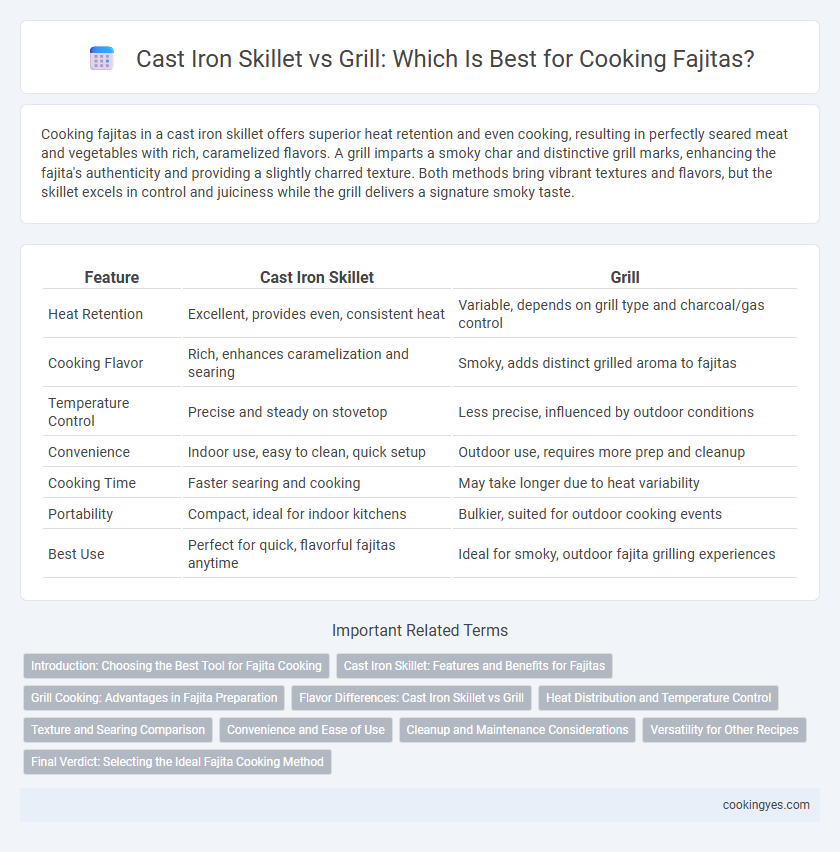Cooking fajitas in a cast iron skillet offers superior heat retention and even cooking, resulting in perfectly seared meat and vegetables with rich, caramelized flavors. A grill imparts a smoky char and distinctive grill marks, enhancing the fajita's authenticity and providing a slightly charred texture. Both methods bring vibrant textures and flavors, but the skillet excels in control and juiciness while the grill delivers a signature smoky taste.
Table of Comparison
| Feature | Cast Iron Skillet | Grill |
|---|---|---|
| Heat Retention | Excellent, provides even, consistent heat | Variable, depends on grill type and charcoal/gas control |
| Cooking Flavor | Rich, enhances caramelization and searing | Smoky, adds distinct grilled aroma to fajitas |
| Temperature Control | Precise and steady on stovetop | Less precise, influenced by outdoor conditions |
| Convenience | Indoor use, easy to clean, quick setup | Outdoor use, requires more prep and cleanup |
| Cooking Time | Faster searing and cooking | May take longer due to heat variability |
| Portability | Compact, ideal for indoor kitchens | Bulkier, suited for outdoor cooking events |
| Best Use | Perfect for quick, flavorful fajitas anytime | Ideal for smoky, outdoor fajita grilling experiences |
Introduction: Choosing the Best Tool for Fajita Cooking
Cast iron skillets offer superior heat retention and even cooking, making them ideal for searing fajita meats and vegetables to achieve a perfect char and caramelization. Grills impart a smoky flavor and distinct grill marks, enhancing the authentic Tex-Mex taste and allowing fat to drip away for a healthier dish. Selecting between a cast iron skillet and a grill depends on available equipment, desired flavor profile, and cooking environment.
Cast Iron Skillet: Features and Benefits for Fajitas
A cast iron skillet offers superior heat retention and even cooking, essential for achieving the perfect sear and caramelization on fajita meat and vegetables. Its ability to maintain high temperatures ensures consistent cooking, while the skillet's heavy construction allows for excellent heat distribution, preventing hot spots that can burn ingredients. Additionally, cast iron skillets can easily transition from stovetop to oven, providing versatility and enhanced flavor development through controlled cooking environments.
Grill Cooking: Advantages in Fajita Preparation
Grill cooking enhances fajita preparation by imparting a smoky char and distinct grill marks that intensify the flavor profile of the meat and vegetables. High, direct heat on a grill sears ingredients quickly, locking in juices and creating a tender, juicy texture ideal for fajitas. Grilling also allows fat to drip away, resulting in a healthier meal with authentic outdoor barbecue aroma.
Flavor Differences: Cast Iron Skillet vs Grill
Cooking fajitas in a cast iron skillet enhances flavor concentration by retaining juices and creating a rich, caramelized crust, while a grill imparts a distinctive smoky char and slightly crisp texture due to open flame exposure. The skillet's consistent high heat promotes even browning and intensified spices absorption, whereas the grill infuses subtle smokiness and grill marks that elevate visual appeal and taste complexity. Choosing between the two methods impacts the final flavor profile, with cast iron delivering depth and moisture, and grilling offering a vibrant, smoky essence.
Heat Distribution and Temperature Control
A cast iron skillet offers superior heat retention and even distribution, ensuring consistent cooking temperatures vital for perfectly seared fajitas. Grills provide high, direct heat but can have uneven heat zones, making temperature control more challenging for delicate ingredients. Precise temperature management on a cast iron skillet helps achieve the ideal caramelization and tenderness essential for authentic fajita flavors.
Texture and Searing Comparison
Cast iron skillets provide even heat retention that delivers a consistent sear, creating a caramelized crust essential for authentic fajita texture, while grills impart a smoky char that enhances flavor with distinct grill marks and a slightly drier exterior. The skillet's surface allows for better control of cooking temperature, ensuring tender, juicy meat with a crisp edge, whereas grilling can result in a more uneven sear but adds a depth of smoky aroma. Both methods excel in texture development, but cast iron skillets offer superior crust formation and moisture retention for fajitas.
Convenience and Ease of Use
Cooking fajitas in a cast iron skillet offers excellent heat retention and even cooking, making it convenient for stovetop use and quick preparation. Grilling fajitas outdoors provides a smoky flavor but requires more setup and attention to monitor temperature changes. For ease of use, cast iron skillets simplify cooking in any weather and allow for precise control, ideal for busy kitchens.
Cleanup and Maintenance Considerations
Cast iron skillets require seasoning after each use to maintain their non-stick surface and prevent rust, with cleaning limited to gentle scrubbing and avoiding soap. Grills, especially outdoor ones, need thorough removal of grease and food residue to prevent flare-ups and corrosion, often involving wire brushes and grill cleaners. Both cooking methods demand regular upkeep, but skillets offer easier indoor maintenance while grills require more comprehensive outdoor cleaning routines.
Versatility for Other Recipes
A cast iron skillet offers exceptional versatility for fajita cooking, allowing precise control over heat and evenly searing meats and vegetables, while also being ideal for dishes like stir-fries, cornbread, and pan-seared steaks. In contrast, a grill imparts a smoky flavor and char marks but is less adaptable for cooking delicate or small ingredients that require consistent, controlled heat. For home cooks seeking a multi-functional tool beyond fajitas, the cast iron skillet provides broader culinary applications and ease of indoor use.
Final Verdict: Selecting the Ideal Fajita Cooking Method
A cast iron skillet offers consistent heat retention and even cooking, ensuring perfectly seared fajita meats and vegetables with a rich, smoky flavor. Grilling imparts a distinct char and outdoor aroma that enhances the authenticity and texture of fajitas. Choosing between the two depends on whether you prioritize indoor convenience and heat control or the smoky, caramelized essence achieved through open-flame grilling.
Cast iron skillet vs Grill for fajita cooking Infographic

 cookingyes.com
cookingyes.com